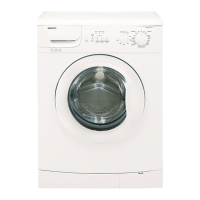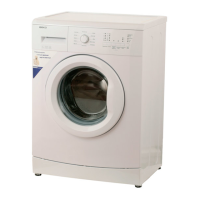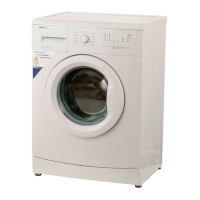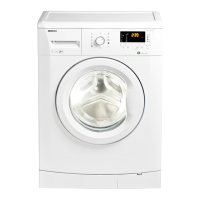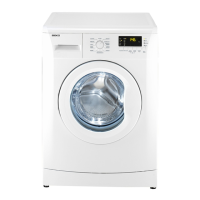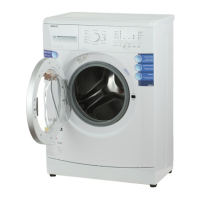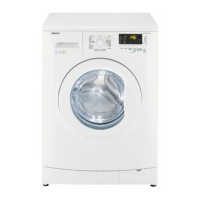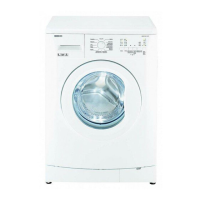
Do you have a question about the Beko WMB 50821 UY and is the answer not in the manual?
Safety instructions for product usage, cleaning, maintenance, and electrical connections.
Product designed for domestic use only, for washing and rinsing marked laundry.
Warnings about packaging materials, electrical hazards, and keeping children away from the product.
Information on recyclable packaging materials and their proper disposal.
Guidelines for disposing of the product as electronic waste and safety measures.
Information on WEEE compliance and recycling of the appliance.
Guidance on placing the machine on a stable floor, away from heat and moisture.
Instructions on how to remove packaging reinforcement before installation.
Steps to remove transportation safety bolts before operating the machine.
Instructions for connecting the water supply, including pressure requirements and hose connections.
Guidelines for connecting the drain hose to wastewater or washbasin, including height and length recommendations.
Instructions for leveling the machine using its adjustable feet for stability and reduced vibration.
Requirements for connecting the machine to a grounded electrical outlet with the correct fuse rating.
Procedures to follow when transporting the washing machine, including securing it.
Guidance on sorting laundry by fabric type, color, and soiling level before washing.
Steps for preparing laundry items, like removing objects from pockets and using laundry bags.
Tips for economical and eco-friendly washing, such as using full loads and lower temperatures.
Instructions for the first use of the machine, including running a drum cleaning cycle.
Information on the maximum load capacity for different laundry types to ensure optimal performance.
Steps for properly loading laundry into the machine for washing.
Detailed instructions on how to use detergent, softener, and other cleaning agents in the machine.
Instructions for using starch, including where to add it and cleaning after use.
Guidelines for using bleaching agents safely and effectively during the wash cycle.
Recommendations for using limescale removers specifically designed for washing machines.
An overview of the washing machine's control panel, identifying buttons and indicators.
Final preparation steps before starting a wash cycle, like checking hoses and adding detergent.
How to select the appropriate wash programme based on laundry type and conditions.
Details on core wash programmes like Cottons, Synthetics, and Woollens.
Explanation of special programmes like Cotton Economic, BabyProtect, and Daily Express.
Information on specific programmes like Rinse, Spin + Drain, and Anti-Creasing.
How to adjust the wash temperature and when it can be changed.
Guidance on selecting and adjusting the spin speed for different wash cycles.
A table detailing programmes, load capacities, durations, consumption, and auxiliary functions.
Explanation of various auxiliary functions like Prewash, Quick Wash, Rinse Plus, and Anti-Creasing.
Instructions on setting a delayed start for wash programmes.
How to start a selected wash programme using the Start/Pause button.
Instructions on activating and deactivating the child lock feature to prevent tampering.
How to monitor the progress of a running wash cycle.
Information about the loading door lock mechanism and its behavior.
Steps for adding or removing laundry during a paused programme.
How to cancel a running programme and select a new one.
Explanation of the machine's standby mode and energy-saving features.
Instructions for cleaning the detergent drawer and its siphon component.
How to clean the door seal and drum, including using the Drum Cleaning programme.
Guidance on cleaning the exterior body and the control panel of the machine.
Steps for cleaning the water intake filters located at the tap and hose connections.
Procedures for draining residual water and cleaning the pump filter.
Troubleshooting steps for issues preventing programme start or selection.
Explanation for residual water in the drum after production quality control.
Solutions for vibration and noise issues, including leveling and checking bolts.
Reasons for temporary stoppage, like low voltage, and how the machine resumes.
Explains why the timer might not count down during specific stages like water intake or heating.
Causes and solutions for excessive foam, often due to too much detergent.
Reasons for laundry being wet, like foam absorption or unbalanced load detection.

